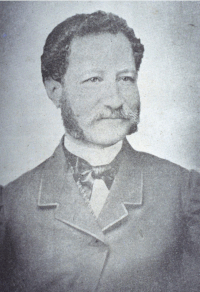Buenaventura Báez
| Ramón Buenaventura Báez Méndez | |
|---|---|
 |
|
|
|
|
|
In office May 29, 1849 – February 15, 1853 |
|
| Preceded by | Manuel Jiménes |
| Succeeded by | Pedro Santana |
|
|
|
|
In office October 8, 1856 – June 13, 1858 |
|
| Preceded by | Manuel de Regla Mota |
| Succeeded by | José Desiderio Valverde |
|
|
|
|
In office December 8, 1865 – May 29, 1866 |
|
| Vice President | Francisco Antonio Gómez y Báez |
| Preceded by | Pedro Guillermo |
| Succeeded by | Triumvirate of 1866 |
|
|
|
|
In office May 2, 1868 – January 2, 1874 |
|
| Vice President | Manuel Altagracia Cáceres y Fernández (1868-1871) Juan Isidro Ortea y Kennedy (1871-1874) |
| Preceded by | Manuel Altagracia Cáceres |
| Succeeded by | Ignacio María González |
|
|
|
|
In office December 26, 1876 – March 2, 1878 |
|
| Vice President | Juan Isidro Ortea y Kennedy |
| Preceded by | Marcos Antonio Cabral |
| Succeeded by | Ignacio María González |
|
|
|
|
In office 1856–1857 |
|
| Preceded by | Antonio Abad Alfau Bustamante |
| Succeeded by | Domingo Daniel Pichardo Pró |
| Personal details | |
| Born |
July 14, 1812 Cabral, Barahona, Captaincy General of Santo Domingo |
| Died | March 14, 1884 (aged 71) Hormigueros, Puerto Rico |
| Nationality | Dominican |
| Political party | Red Party |
| Spouse(s) | Fermina Andújar de Soto |
| Relations |
Marcos Antonio Cabral (son-in-law) Virgins of Galindo (nieces-in-law) |
| Children | At least 9 children, some sources have attributed more children to him |
| Religion | Catholic |
Buenaventura Báez, in full Ramón Buenaventura Báez Méndez (July 14, 1812 – March 14, 1884) was the President of the Dominican Republic for five nonconsecutive terms. He is known for attempting to annex the Dominican Republic to other countries on multiple occasions. His son Ramón Báez was briefly president in 1914.
Báez was born in Cabral, Barahona, of the Captaincy General of Santo Domingo. Báez's mother, Juana Méndez was formerly enslaved and his father, Pablo Báez, was a wealthy merchant from Azua. Báez inherited a fortune from his father and because of it was able to study in Europe. There, he learned various languages including English and French.
During the annexation by Haiti, Báez served as the legislator/congressman of Azua to the ruling Haitian government. This post was gained in part because of his role in the revolution that overthrew President Jean-Pierre Boyer from power.
Baez was completely and totally against the move to leave the union with Haiti. He opposed the Trinitarios and imprisoned some of them and did not allow the new flag to be raised in city plaza. He changed his mind once he saw the popular mood and decided that the time had come to part ways with Port-au-Prince. Baez was no fool and would always find a way to allow opportunity to shine upon him.
In 1844, Báez helped to lead a successful rebellion against Haiti, which established the independence of the Dominican Republic. He went to Europe in 1846 to convince France to establish a protectorate over the Dominican Republic, but the French refused. As president for the first time, from 1849 until 1853, he attempted to convince the United States to take over the country. He was President again from 1856 until 1857, when he was deposed in a coup.
Báez next supported the idea of having the Dominican Republic be taken over by Spain. He went into exile in Spain and led a luxurious life there. The Spanish agreed to occupy the Dominican Republic in 1861, but by 1865 they had abandoned it (see Dominican Restoration War). Báez then returned to the Dominican Republic and became President again until he was deposed in another coup in May 1866. He then served his longest term as President, from 1868 until 1874, during which time he again attempted to have the United States annex the Dominican Republic. This time he was almost successful, as he convinced American President Ulysses S. Grant to send warships to the Dominican Republic, and drew up an annexation treaty which reached the United States Senate floor. The treaty, however, was not ratified in the US Senate, and it became an embarrassment for Grant.
...
Wikipedia
